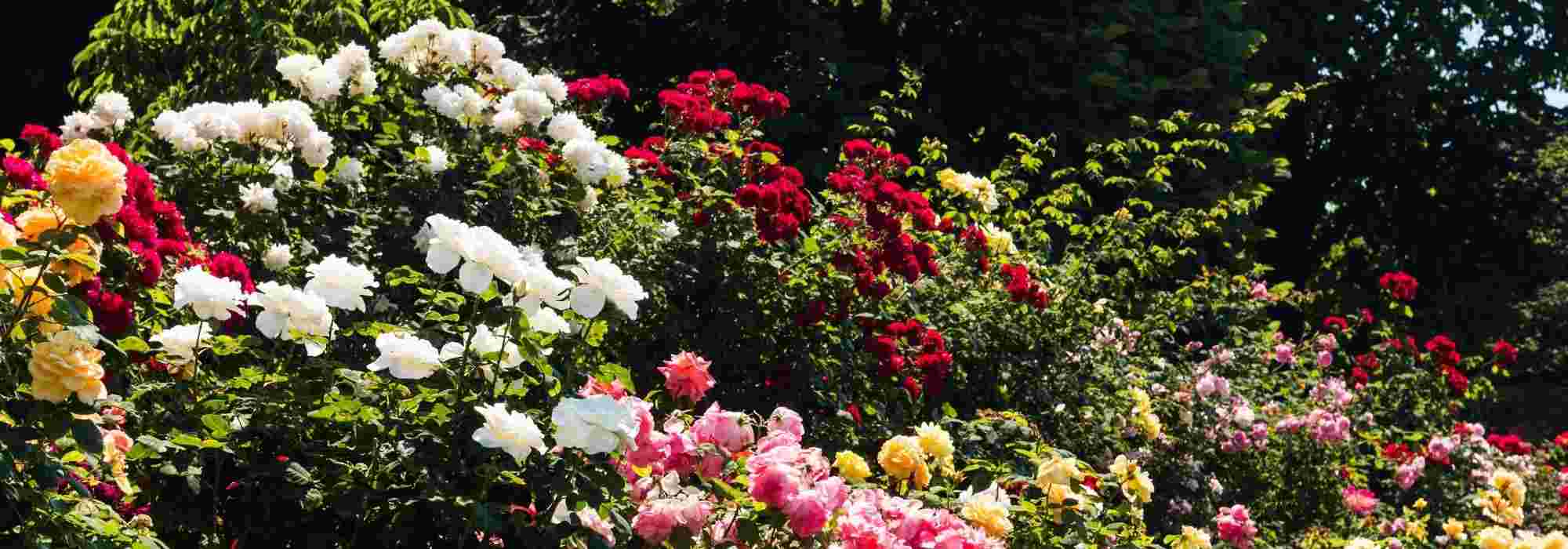
6 tips for creating a beautiful rose bed
Tips and ideas for companion planting
Contents
Rose bushes are present in many gardens, grown alone, in pots, to adorn a pergola or combined with other plants. They can create all kinds of ambience, natural or sophisticated, romantic or wild. Roses are also perfect for creating a beautiful flower bed. This will not necessarily require much maintenance, but a few recommendations will help you plan it better and make it easily attractive. Variations in height, colour schemes, continuous flowering, variation in shapes and textures, plants to combine… Discover our tips to organise and grow a beautiful rose bed!
Depending on their pruning and silhouettes
For a beautiful rose bed, very common bush roses, with a dense, compact habit, are ideal. Their modest height of just 1 metre does not prevent them from offering abundant flowering.
Among them, there are bush roses with large flowers (or Hybrid Tea), classics found in many gardens, and bush roses with clustered flowers, which are very floriferous.
Slightly taller, bush roses also suit a bed, to vary heights and silhouettes and emphasise contrasts.
The standard roses (‘Toscana’, ‘New Dawn’, ‘Rochemenier Village’, ‘Fiesia’…) are not much larger and form true small bushes with an elegant habit: their trunk bears a ball of roses, sometimes trailing (weeping roses) for a beautiful cascading effect. In beds, their bases can easily be dressed with perennials.
It is perfectly possible to combine several species of roses to play with heights, shapes and flower styles (single, double, large-flowered, old roses…).
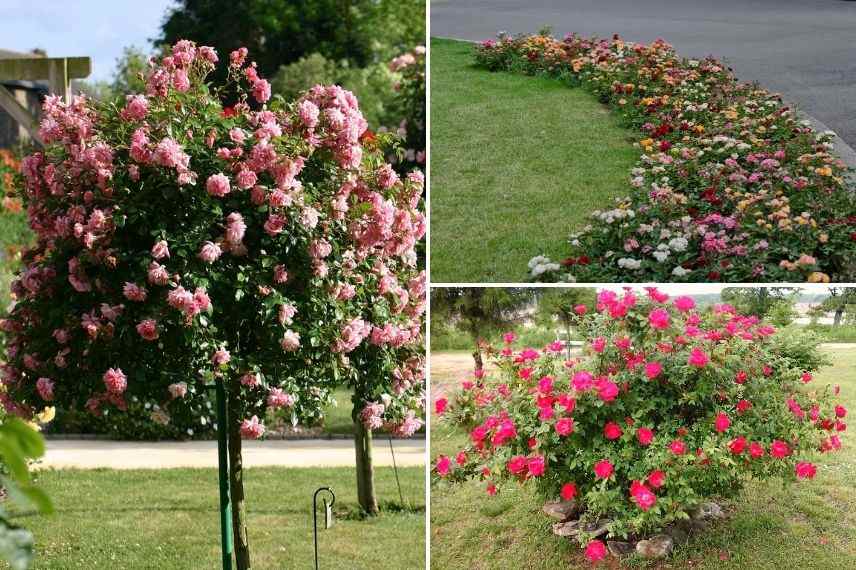
Standard rose, bush rose and bush rose.
Create a harmonious colour scheme
White, orange, yellow, mauve, purple, the ever-popular red and pink or even bicolours… Choice of colours is plentiful when it comes to roses.
Everything is, of course, a matter of taste, but to create a harmonious rose bed, showcasing flowers and colours, ideally opt for :
- either for roses in complementary colours
- or for one or two colours, expressed in several shades to achieve a lovely tonal range
For a romantic touch, white is naturally the star colour, but combining blue-violet flowers (‘Rhapsodie in Blue’,‘Minerva’, ‘Blue Moon’, ‘Sissi’, ‘Pacific Dream’…) and pink flowers can also bring a truly delicate note.
Pairing yellow-flowered roses with blue-violet or purple roses also works very well.
For a more exotic, punchy atmosphere, red and orange (‘Bentheimer Gold’, ‘Urban Streetlight Phoenix’, ‘Louis de Funès’…) will create a perfect pairing.
White paired with pink gives a more classic yet very soft look, while purple (‘Purple Voluptia’) and violet bring a touch of warmth.
A gradation of pink-toned roses can also be stunning.
Finally, white roses add a touch of light, alone or to highlight another dominant colour.
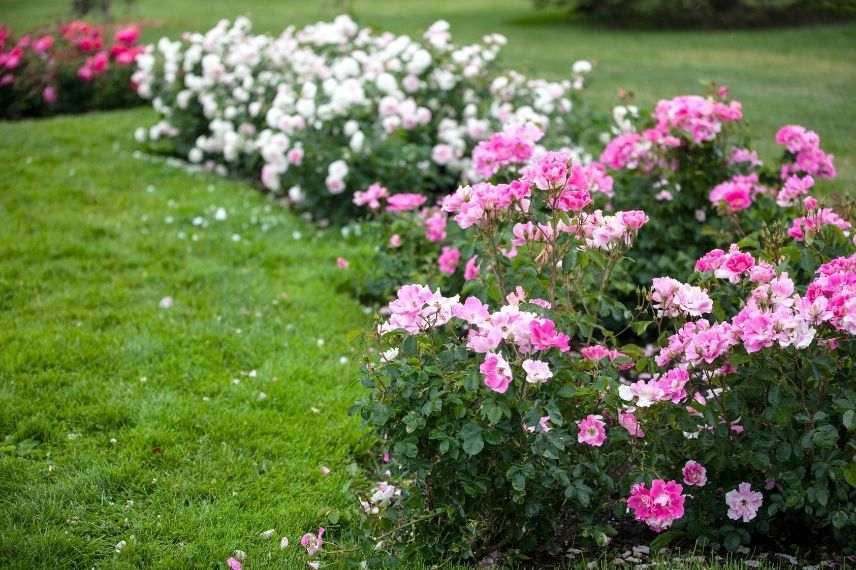
Discover other Roses
View all →Available in 0 sizes
Available in 2 sizes
Available in 3 sizes
Available in 2 sizes
Available in 3 sizes
Available in 1 sizes
Available in 2 sizes
Available in 2 sizes
Available in 2 sizes
Available in 3 sizes
Select roses with complementary flowering periods
Thanks to staggered flowering, enjoy roses in your border from spring to autumn.
Some rose varieties begin flowering as early as May (‘Martin des Senteurs’, ‘Friesia’, ‘Pink Eureka’ or the charming dwarf rose ‘Little Sunset’), while others flower until first winter frosts (such as large-flowered roses ‘Sweet Love’, ‘Belles Rives’ and ‘Dame de coeur’).
Opt for perpetual roses, which flower several times a year and will ensure an almost uninterrupted flowering, except in autumn and winter.
Preventing diseases
Roses can be susceptible to diseases caused by fungi (caused by a fungus), such as marsonia, responsible for black spots on leaves, powdery mildew, which leaves a white coating, or rust, recognisable by its pustules.
These diseases are particularly unsightly, and should be avoided to preserve an attractive flower bed.
You can opt for disease-resistant varieties. This includes varieties bearing the German ADR label, such as roses ‘Iceberg’, ‘Garden of roses’ or ‘Jacques Cartier’.
And to prevent disease:
- grow roses in well-drained soil that will not retain excess moisture and allows water to drain away;
- choose planting locations that allow air to circulate, while avoiding exposure to prevailing winds;
- avoid planting a rose where another rose was previously grown;
- water at the base of the rose, always avoiding wetting the foliage;
- grow companion plants, such as alliums, lavender, rosemary, nepeta, artemisia…
- conversely, avoid pairing with plants that are susceptible to the same diseases, such as hollyhocks, mallow or asters;
- if disease develops, spot-treat with a natural fungicidal treatment, nettle manure or a horsetail decoction.

Marsonia, powdery mildew and rust.
Pairing roses with other plants: some companion planting ideas
There are many ways to combine roses with other plants:
- bulbous plants
- perennial plants
- grasses
- annuals
Mixing roses with different plants also helps to promote biodiversity and naturally attract beneficial insects to the garden.
To allow air to circulate and limit disease while enabling good plant development without root competition, place other plants about 30 to 40 cm from roses.
Taller plants should be placed at back of border, while smaller ones are grown in front.
Finally, choose plants with the same soil and light requirements: soil rich in organic matter, cool (retaining moisture) yet well drained (no stagnant water), in full sun.
With spring bulbs
Spring bulbs are perfect for signalling start of spring and kick-starting flowering of a border: muscari, daffodils, early tulips, crocus, scillas… Their flowering will finish more or less when roses begin to open.
With ornamental foliage plants
Ornamental foliage plants highlight roses and their colours while bringing a touch of modernity: hostas, ferns, grasses such as stipa, carex, and heucheras.
Small bushes are also very effective: rosemary, savory, box or berberis.
A little more demanding in space but adding an original touch, you can perfectly well grow vegetables in association, such as chard with very ornamental coloured foliage, or cardoons.
With annuals or biennials
If you prefer to change the look regularly, opt for annuals or biennials, to renew each year or every two years if they do not self-seed: honesty (lunaria), cosmos, poppy, love-in-a-mist (Nigella damascena), zinnias, the very melliferous borage, or its unjustly neglected cousin, the beautiful cerinthe.
Long flower spikes of amaranths will in turn add a harmonious vertical accent.
With other perennial plants
Spike-shaped flowers add height, create a striking graphic effect and contrast with round-shaped rose flowers. This is the case, for example, with delphiniums, lupins, agapanthus, salvias or briza media. Bell-shaped flowers, such as bellflowers, will also create a pleasing contrast of forms.
Valerians, perennial geraniums, which flower almost all year, geums and lady’s mantle will also look lovely.
Planting at base of roses
Groundcovers or perennial plants will nicely adorn the base of roses. But to dress them more prominently, you can also opt for climbing plants that are not smothering, such as clematis, morning glories, nasturtiums (beware of aphids they tend to attract) or sweet peas. They are particularly suited to bases of standard roses.
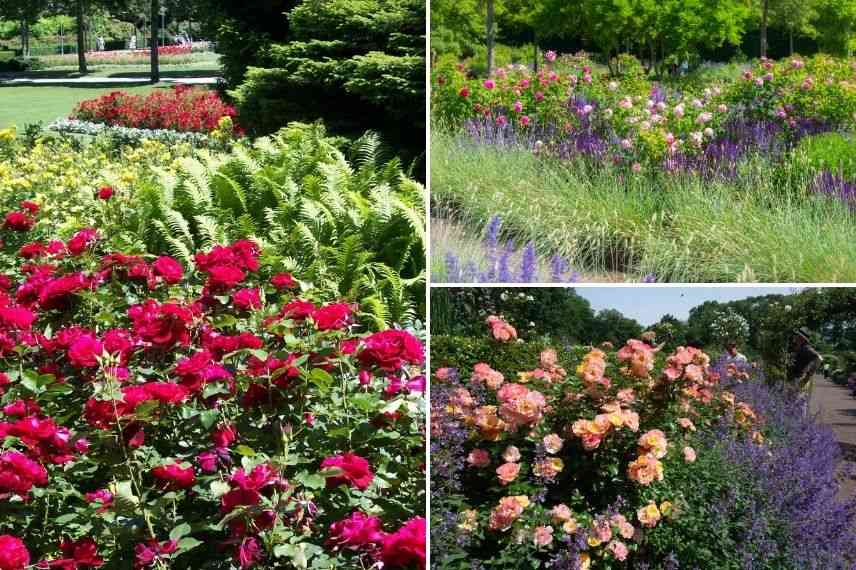
(Photos: left Ethan Gruber, bottom right Allison Meier)
A little maintenance to keep a beautiful rose bed
While roses do not require major, overly frequent maintenance, a few simple actions will help keep a beautiful rose bed:
- a generous addition of compost or natural fertilisers for roses in early spring will encourage flowering;
- prune roses after flowering (non-perpetual varieties) or in late winter (perpetual varieties) to ensure good regrowth and attractive future flowering;
- mulch around roses before winter and first frosts to protect them;
- if you have chosen to grow perennials, prune yellowing or damaged foliage in autumn to help plants regrow well come next spring.
- Subscribe!
- Contents
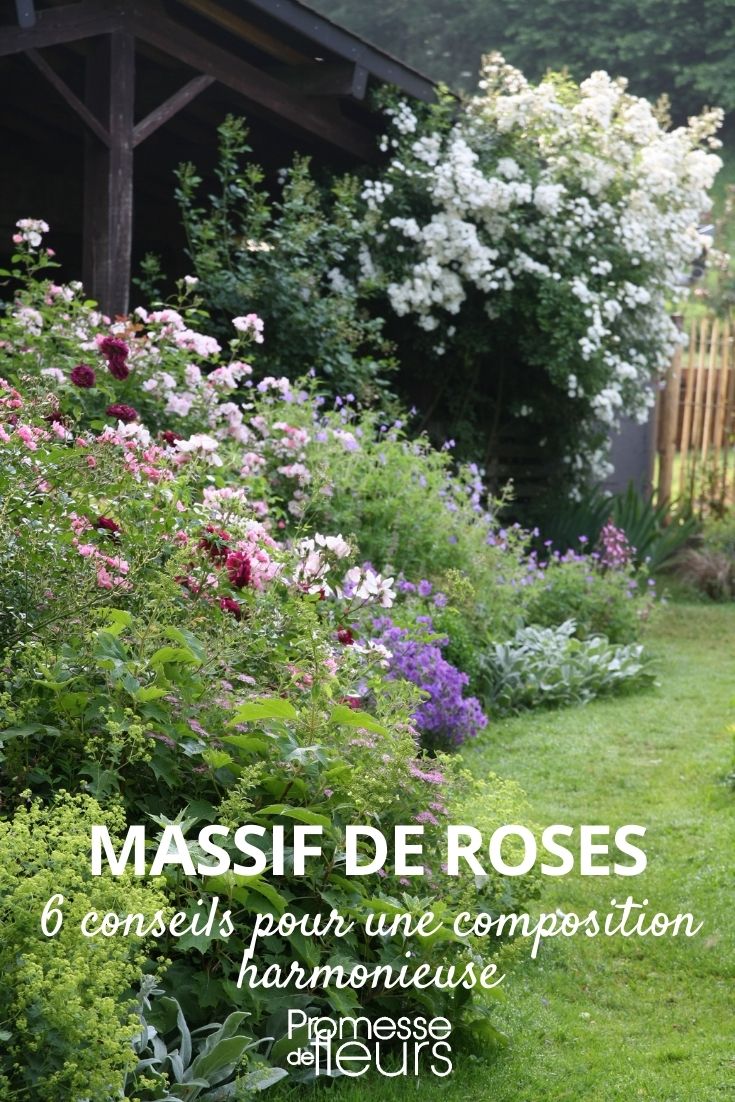































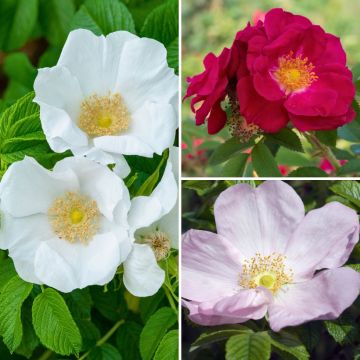
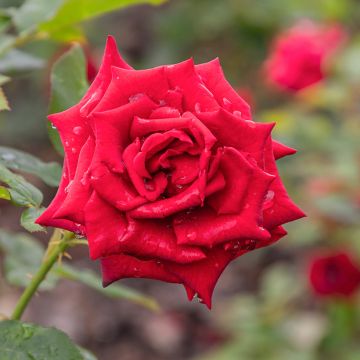
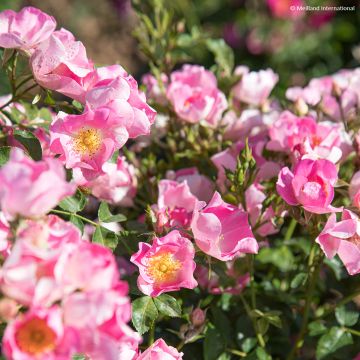

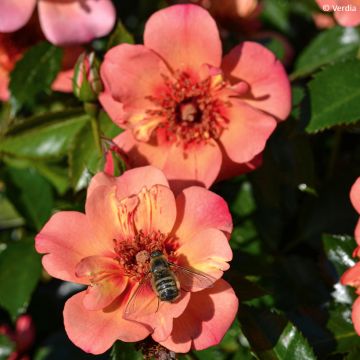
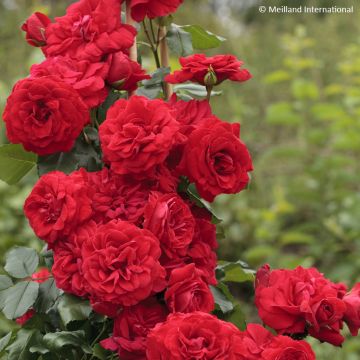
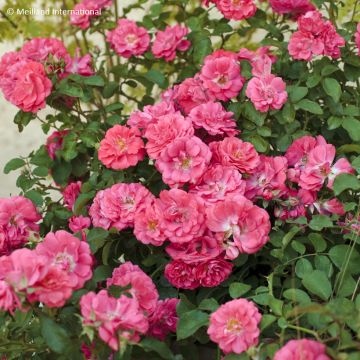
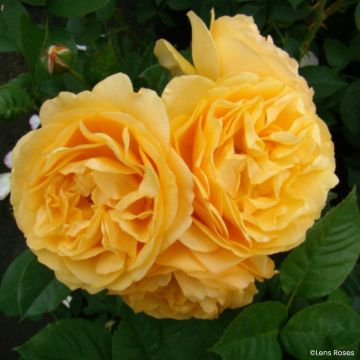
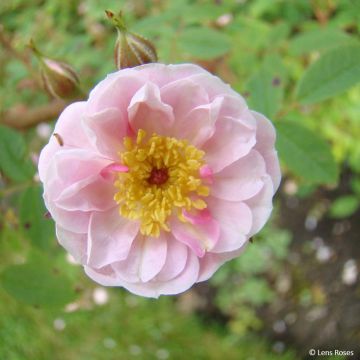
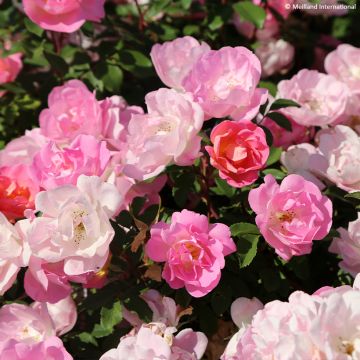
Comments